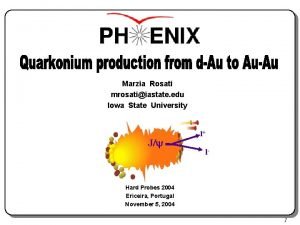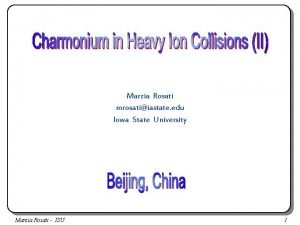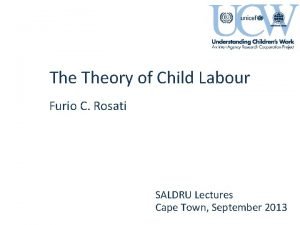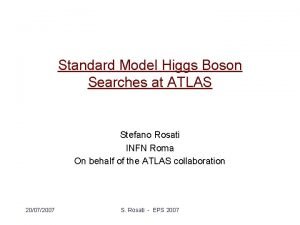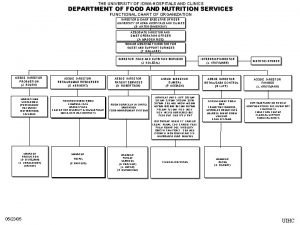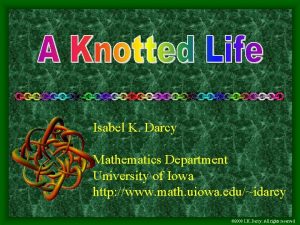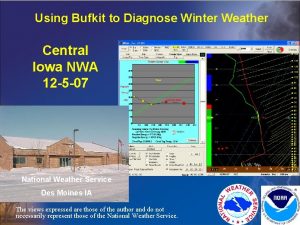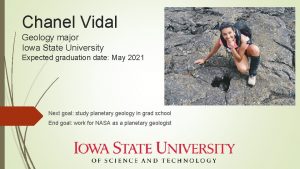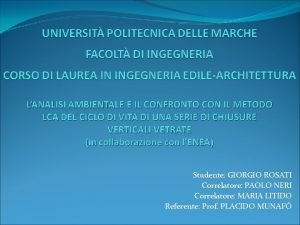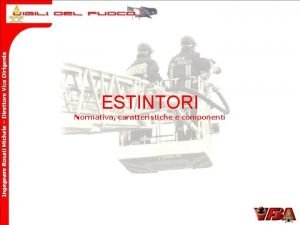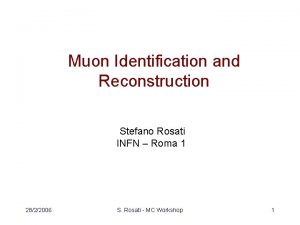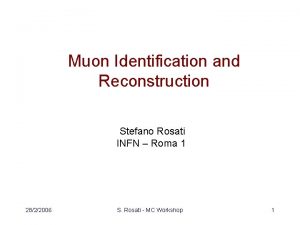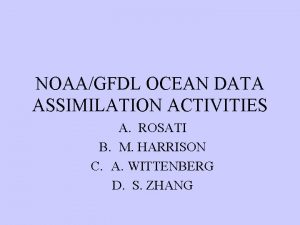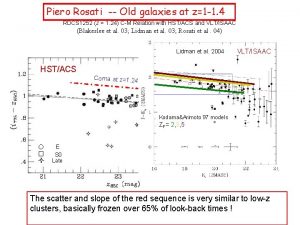Marzia Rosati mrosatiiastate edu Iowa State University J
























- Slides: 24

Marzia Rosati mrosati@iastate. edu Iowa State University J/ l+ l- Hard Probes 2004 Ericeira, Portugal November 5, 2004 Marzia Rosati - ISU 1

Outline Ø Charmonium at RHIC Ø The PHENIX Detector Ø Charmonium Measurements in PHENIX Ä p-p Collisions Äd-Au Collisions ÄFirst Measurement in Au-Au Collisions Ø Summary, conclusions, and outlook. Marzia Rosati - ISU 2

Charmonium Physics at RHIC Ø We expect a screening of the attractive potential as we approach the deconfinement transition Ø This color screening may results in a decrease in the number of heavy quarkonia states Ø Alternative models predict enhancement from c -cbar coalescence as the collision volume cools. ðComparisons between various collision species are very important. ðStudies done via both dielectron and dimuon channels in PHENIX. Marzia Rosati - ISU 3

PHENIX Collaboration Brazil China University of São Paulo, São Paulo Academia Sinica, Taipei, Taiwan China Institute of Atomic Energy, Beijing Peking University, Beijing France LPC, University de Clermont-Ferrand, Clermont-Ferrand Dapnia, CEA Saclay, Gif-sur-Yvette IPN-Orsay, Universite Paris Sud, CNRS-IN 2 P 3, Orsay LLR, Ecòle Polytechnique, CNRS-IN 2 P 3, Palaiseau SUBATECH, Ecòle des Mines at Nantes, Nantes Germany University of Münster, Münster Hungary Central Research Institute for Physics (KFKI), Budapest Debrecen University, Debrecen Eötvös Loránd University (ELTE), Budapest India Banaras Hindu University, Banaras Bhabha Atomic Research Centre, Bombay Israel Weizmann Institute, Rehovot Japan Center for Nuclear Study, University of Tokyo, Tokyo Hiroshima University, Higashi-Hiroshima KEK, Institute for High Energy Physics, Tsukuba Kyoto University, Kyoto Nagasaki Institute of Applied Science, Nagasaki RIKEN, Institute for Physical and Chemical Research, Wako RIKEN-BNL Research Center, Upton, NY Rikkyo University, Tokyo, Japan Tokyo Institute of Technology, Tokyo University of Tsukuba, Tsukuba Waseda University, Tokyo S. Korea Cyclotron Application Laboratory, KAERI, Seoul Kangnung National University, Kangnung Korea University, Seoul Myong Ji University, Yongin City System Electronics Laboratory, Seoul Nat. University, Seoul Yonsei University, Seoul Russia Institute of High Energy Physics, Protovino Joint Institute for Nuclear Research, Dubna Kurchatov Institute, Moscow PNPI, St. Petersburg Nuclear Physics Institute, St. Petersburg State Technical University, St. Petersburg Sweden Lund University, Lund 12 Countries; 58 Institutions; 480 Participants* Marzia Rosati - ISU *as of January 2004 USA Abilene Christian University, Abilene, TX Brookhaven National Laboratory, Upton, NY University of California - Riverside, CA University of Colorado, Boulder, CO Columbia University, Nevis Laboratories, Irvington, NY Florida State University, Tallahassee, FL Florida Technical University, Melbourne, FL Georgia State University, Atlanta, GA University of Illinois Urbana Champaign, Urbana-Champaign, IL Iowa State University and Ames Laboratory, Ames, IA Los Alamos National Laboratory, Los Alamos, NM Lawrence Livermore National Laboratory, Livermore, CA University of New Mexico, Albuquerque, NM New Mexico State University, Las Cruces, NM Dept. of Chemistry, Stony Brook Univ. , Stony Brook, NY Dept. Phys. and Astronomy, Stony Brook Univ. , Stony Brook, NY Oak Ridge National Laboratory, Oak Ridge, TN University of Tennessee, Knoxville, TN Vanderbilt University, Nashville, TN 4

PHENIX Detector Event characterization detectors in middle Two central arms for measuring hadrons, photons and electrons Two forward arms for measuring muons J/ ee in central arms electron measurement in range: | | 0. 35 pe 0. 2 Ge. V/c Marzia Rosati - ISU J/ in forward arms muon measurement in range: 1. 2 < | | < 2. 4 pm 2 Ge. V/c 5

Electron Identification Ø PHENIX has excellent electron identification capabilities. Ä Ring Imaging Cherenkov Counter - threshold selection Ä TEC/TRD - d. E/dx and TR measurement Ä Electromagnetic Calorimeter - Energy-Momentum match All charged tracks Apply RICH cut Real Net signal Background EMC energy / Momentum Marzia Rosati - ISU 6

Di-electron analysis Example : d. Au sample Ø Identify electron • RICH ring cut • 0. 5 < E/p < 1. 5 Ø Di-electron invariant mass spectra Ø Subtract combinatorial background • Signal = N+- - ( N++ + N--) Count J/ Ø Correct for acceptance and efficiencies Cross section Mass Resolution ~ 100 Me. V Marzia Rosati - ISU 7

Muon Measurements Muon tracker (Mu. TR) 3 stations of cathode strip chambers per arm Muon identifier (Mu. ID) 5 gaps per arm filled with planes of transversely oriented Iarocci tubes Marzia Rosati - ISU 8

Di-muon analysis Example : d. Au North Arm Sample Ø Identify muons Ä Depth in Identifier Ø Di-muon inv. mass spectra Ø Subtract combinatorial backgrounds Ä Signal = N+- -2 (N++)(N--) Ø Work in progress to quantify physical backgrounds : Ä Open charm & beauty, Drell -Yan, a hint of ’ For now: fit gauss J/ +exp bg Mass Resolution ~ 150 to 200 Me. V Marzia Rosati - ISU Ø Correct for acceptance and efficiencies Cross section 9

Do we understand the basic production mechanism? Ø The production mechanism of charmonium in p-p collisions is not yet well understood. Ä Color evaporation model, Color singlet model, Color octet model Ä Polarization, Rapidity dependence (electron and muon channels) Ä Production of J/ , ', . . states Ø We need a good measurement of J/ cross section in p+p at RHIC Ä Base line for p. A and AA Marzia Rosati - ISU 10

J/Y in p+p Collisions @ 200 Ge. V (2002 data) + – Phys. Rev. Lett. 92, 051802, 2004 e+ e– Results consistent with shapes from various models and PDF. Take the PYTHIA shape to extract our cross-section Integrated cross-section : 234 ± 36 (stat) ± 34 (sys) ± 24(abs) nb Marzia Rosati - ISU 11

Energy Scaling Ø Phenomenological fit for average p. T Ä p = 0. 531, q= 0. 188 Ø Cross-section well described by e. g. Color Evaporation Model. Marzia Rosati - ISU 12

J/Y in p+p Collisions @ 200 Ge. V (2003 Preliminary data) total cross section from Run 2 data BR. tot = 234 36 34 24 nb total cross section from Run 3 data BR. tot = 159 nb 8. 5 % 12. 3 % Marzia Rosati - ISU 13

Charmonium in d-Au Collisions Ø Study of "normal nuclear effects": shadowing and energy loss ÄNuclear dependence of (J/ ): A or abs (nuclear absorption) Äd. E/dx not expected to be significant effect at RHIC energies ÄOverall absorption expected ÄBase line for AA Marzia Rosati - ISU 14

d-Au Collisions Eskola, Kolhinen, Vogt hep-ph/0104124 South Muon Arm North Muon Arm Au d PHENIX μ, North PHENIX , SOUTH Central Arm PHENIX e Ø PHENIX measurements cover different ranges of the Au parton momentum fraction where shadowing and anti-shadowing are expected Ä South (y < -1. 2) : large X 2 (in gold) ~ 0. 09 Ä Central (y ~ 0) : intermediate X 2 ~ 0. 02 Ä North (y > 1. 2) : small X 2 (in gold) ~ 0. 003 Marzia Rosati - ISU 15

Cross section versus p. T J/ + - High x 2 ~ 0. 09 Low x 2 ~ 0. 003 <p. T 2> = <p. T 2>d. Au – <p. T 2>pp 1. 77 ± 0. 35 Ge. V 2 1. 29 ± 0. 35 Ge. V 2 (preliminary) p. T is broadened for d. Au Marzia Rosati - ISU 16

d. Au/pp versus p. T broadening comparable to lower energy ( s = 39 Ge. V in E 866) Low x 2 ~ 0. 003 High x 2 ~ 0. 09 Marzia Rosati - ISU 17

J/Y Rapidity Distribution in d. Au and pp Marzia Rosati - ISU 18

d. Au/pp versus rapidity Rd. A compared to lower s Low x 2 ~ 0. 003 (shadowing region) 1 st J/ψ’s at large negative rapidity! Ø Data favors (weak) shadowing + (weak) absorption ( > 0. 92) Ø With limited statistics difficult to disentangle nuclear effects. Marzia Rosati - ISU 19

Charmonium in Au-Au Collisions Ø Study of "medium effect" in high density matter Ä J/ suppression : signature of QGP Ä J/ formation by c quark coalescence Ø Experimental plan is to establish that the (to be observed) charmonium suppression/enhancement pattern results from QGP Ä Study vs. p. T Ä Study vs. centrality Ä Study in lighter systems Ä Study vs. a control Marzia Rosati - ISU 20

J/Y in Au+Au Collisions @ 200 Ge. V (2002 data) Phys. Rev. C 69, 014901, 2004 y = 1. 0 Coalescence model (Thews et al) y = 4. 0 Stat. Model (Andronic et al. ) Absorption model (Grandchamp et al. ) Ø Disfavor models with enhancement relative to binary collision scaling. Cannot discriminate between models that lead to suppression relative to binary collision scaling. Marzia Rosati - ISU 21

J/Y in Au+Au Collisions @ 200 Ge. V (2004 data) PHENIX Work in progress J/ signal Ø Analysis underway of a data sample (240 b-1 minbias events, 270 TB) Ø Example of Dimuon invariant mass South arm - Peripheral Au. Au Collisions Ø (40 -92%) (~30% of data set) Ø Example of Dielectron invariant mass minium bias sample Ø ( < 10% of data set) Marzia Rosati - ISU 22

Near future at RHIC Ø Full exploration of J/ Y and Y’ production versus “Nbinary” Ø Look forward to future runs with high luminosity where also studies for different collision species and with varying energy can be made Ø Cool-down of the RHIC ring for the upcoming run will start on Nov 8 Ä Cu. Cu collisions and long p-p run Marzia Rosati - ISU 23

Summary Ø p+p collisions: Ä we measured total and differential J/ cross section, vs pt and y Ø d+Au collisions: Ä evidence for weak shadowing and weak nuclear absorption Ä evidence for pt broadening when comparing <pt 2>d+Au vs <pt 2>p+p Ø Au+Au collisions: Ä Run 2 (2002) has low luminosity Ä Run 4 (2004) has 50 times more data, presently being analyzed Ä New Cu-Cu run about to start STAY TUNED ! More on “Heavy flavor production in PHENIX” by Olivier Drapier tomorrow Marzia Rosati - ISU 24
 Marzia rosati
Marzia rosati Marzia rosati
Marzia rosati Aina marzia
Aina marzia Iowa state university intramurals
Iowa state university intramurals Iowa state accounts receivable
Iowa state accounts receivable Carol rosati
Carol rosati Ron rosati
Ron rosati Fred rosati
Fred rosati Atlas
Atlas University of iowa hospital and clinics departments
University of iowa hospital and clinics departments University of iowa college of dentistry
University of iowa college of dentistry Uiowa hawk irb
Uiowa hawk irb Studi kepemimpinan iowa
Studi kepemimpinan iowa Iowa state sona
Iowa state sona University of iowa math
University of iowa math Iowa mock trial
Iowa mock trial Fastx uiowa
Fastx uiowa Bufkit
Bufkit Iowas state tree
Iowas state tree Iowa state intramurals
Iowa state intramurals Iowa state snowmobile association
Iowa state snowmobile association Daryl herzmann
Daryl herzmann Chanel vidal
Chanel vidal Student success center iowa state
Student success center iowa state Alissa stoehr iowa state
Alissa stoehr iowa state
